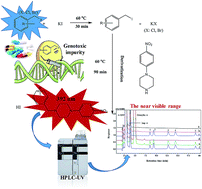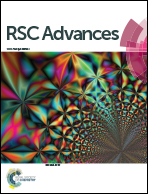A new HPLC-UV derivatization approach for the determination of potential genotoxic benzyl halides in drug substances†
Abstract
Benzyl halides, widely used as alkylation reagents in drug synthesis, are potential genotoxic impurities (PGTIs) required to be controlled at trace levels. However, the existing analytical methods for benzyl halides often suffer from matrix interferences or low derivatization efficiency of benzyl chlorides. In this paper, a simple derivatization HPLC-UV method was developed for the analysis of these residual trace benzyl halides in drug substances. 1-(4-Nitrophenyl) piperazine (4-NPP) was selected as a new derivatization reagent because it shifted well the benzyl halides derivatives away to the near visible range (392 nm), which could minimize the matrix interferences from the drug substances and related impurities. Meanwhile, potassium iodide (KI) was used to convert the mixed benzyl halides into benzyl iodides before derivatization. The derivatization parameters were also optimized using the design of experiments (DoE) for achieving the best reaction efficiency. The results showed that the new approach had high specificity and sensitivity, and the LOQs were 7–9 μg g−1 relative to 5 mg mL−1 antipyrine and 17.5–22.5 μg g−1 relative to 2 mg mL−1 oroxylin A. The method is a valuable alternative for the determination of residual benzyl halides in the drug substances.



 Please wait while we load your content...
Please wait while we load your content...